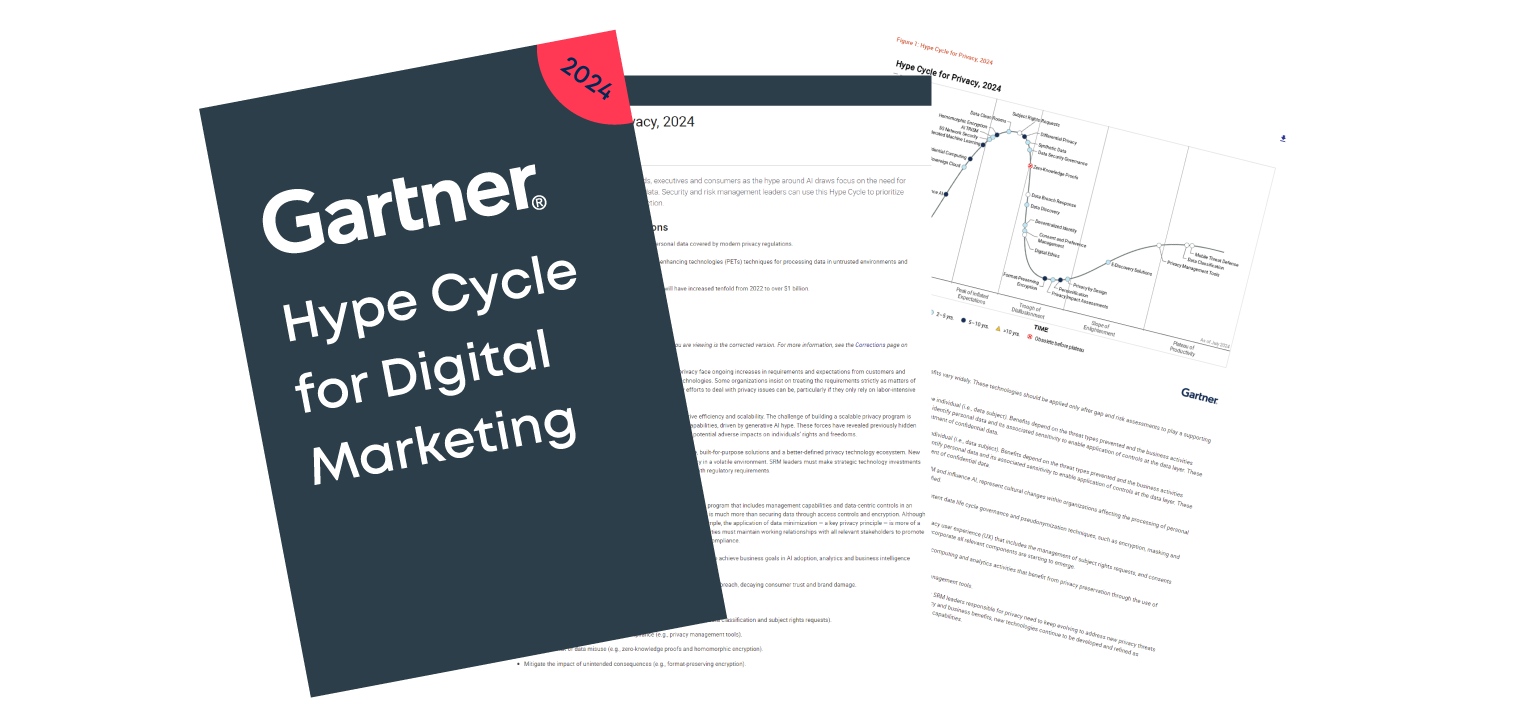TrustOps: Enhancing organizational trust in the age of AI
Posted: September 10, 2024
Generative AI is revolutionizing industries and trust has become a critical currency.
A Forbes Advisor survey found that 76% of consumers are concerned about misinformation from AI tools like Google Bard, ChatGPT, and Bing Chat, highlighting the growing trust deficit in digital interactions.
Enter TrustOps, a framework designed to bolster organizational trust in the digital age. As highlighted in the Gartner Hype Cycle for Digital Marketing 2024, TrustOps is emerging as a pivotal strategy for businesses navigating the complexities of AI and digital marketing.
This blog explores the essence of TrustOps, its role in mitigating AI risks, and how it can be integrated with consent management to build a trustworthy brand.
Understanding TrustOps
TrustOps, short for Trust Operations, is a systematic approach to managing and enhancing trust within an organization. It encompasses a set of principles and practices aimed at ensuring transparency, accountability, and ethical behavior in all operations, particularly those involving AI. In the context of rapid AI advancements, TrustOps is crucial. AI technologies, while powerful, can also be opaque and prone to biases. TrustOps provides a framework for organizations to navigate these challenges, ensuring that AI systems are transparent, fair, and aligned with ethical standards. This is essential not only for maintaining customer trust but also for regulatory compliance and long-term sustainability.
The role of TrustOps in mitigating AI risks
Generative AI, which includes technologies like deepfakes and AI-generated content, poses significant risks. These include the spread of misinformation, erosion of public trust, and potential misuse for malicious purposes. The ability of AI to create highly realistic but false content can undermine the credibility of information and create societal harm. TrustOps addresses these risks by embedding principles of transparency and accountability into AI operations. This involves rigorous auditing of AI systems, ensuring that AI-generated content is clearly labeled, and implementing stringent ethical guidelines. By delivering on a culture of ethical AI use, TrustOps helps organizations mitigate the risks associated with generative AI, thereby protecting their reputation and maintaining public trust.
Integrating Consent Management with TrustOps
Consent management refers to the processes and systems used to obtain, track, and manage user consent for data collection and processing. It is a critical component of digital marketing, ensuring that organizations comply with data protection regulations and respect user privacy.
Integrating consent management with TrustOps enhances data privacy and user trust. TrustOps provides the ethical framework, while consent management ensures that user data is handled transparently and with explicit permission. This synergy not only strengthens compliance with regulations like GDPR but also builds a foundation of trust with users, who feel more secure knowing their data is managed responsibly.
Best practices for implementing Consent Management within a TrustOps framework
- Clear and concise consent requests: Ensure that consent requests are straightforward and easy to understand, avoid legal jargon and provide clear explanations of what data is being collected and how it will be used.
- Regular audits of data handling practices: Conduct regular audits to ensure that data handling practices comply with consent agreements and regulatory requirements, supporting in identifying and rectifying any discrepancies or issues promptly.
- User access to manage Consent Preferences: Provide users with easy access to manage their consent preferences, including options to withdraw consent, update preferences, and view what data has been collected.
- User-friendly and transparent systems: Design consent management systems to be user-friendly and transparent, delivering a positive user experience and encourages users to trust the organization with their data.
- Continuous education and training: Regularly train employees on TrustOps principles and consent management practices, ensuring consistent implementation across the organization and keeps staff updated on the latest regulations and best practices.
- Transparent communication: Maintain open lines of communication with users regarding data use. Regularly inform them about how their data is being used and any changes to data handling practices.
- Data security measures: Implement strong data security measures to protect user data from breaches and unauthorized access, including encryption, access controls, and regular security assessments.
Building a trustworthy brand with TrustOps and Consent Management
To build a trustworthy brand, organizations should adopt a holistic approach that integrates TrustOps and consent management. This involves several key strategies:
- Develop clear policies on data use: Establish and communicate clear, transparent policies regarding how data is collected, used, and protected. Ensure these policies are easily accessible to customers and regularly updated to reflect any changes in practices or regulations.
- Regular communication with customers: Maintain open and ongoing communication with customers about their data. This includes informing them about how their data is being used, any changes to data policies, and the measures in place to protect their privacy. Regular updates can help build and maintain trust.
- Commitment to ethical AI practices: Demonstrate a strong commitment to ethical AI practices. This includes ensuring that AI systems are designed and operated in a way that is transparent, fair, and aligned with ethical standards. Regularly audit AI systems to identify and mitigate any biases or ethical concerns.
- Employee training and awareness: Train employees on TrustOps principles and consent management practices. Ensure that all staff understand the importance of data privacy and ethical AI and are equipped to implement these principles in their daily work.
- User-friendly Consent Management Systems: Implement consent management systems that are easy for users to navigate. Provide clear options for users to manage their consent preferences, including the ability to withdraw consent at any time.
- Transparency and accountability: Build a culture of transparency and accountability within the organization. This includes being open about data breaches or other issues and taking responsibility for addressing them promptly and effectively.
The future of TrustOps in Digital Marketing
Looking ahead, TrustOps is poised to become a cornerstone of digital marketing strategies. As AI technologies continue to evolve, the need for more stringent trust frameworks will only grow. The Gartner Hype Cycle predicts that TrustOps will gain widespread adoption, driven by increasing regulatory pressures and consumer demand for transparency. The long-term benefits of adopting TrustOps and consent management are substantial. Organizations that prioritize trust are likely to see enhanced brand credibility, stronger customer loyalty, and improved operational efficiency. By embedding trust into their core operations, businesses can navigate the complexities of the digital age with confidence and integrity.
Integrating the TrustOps framework with consent management, organizations can mitigate AI risks, ensure data privacy, and build a trustworthy brand. Explore TrustOps and consent management further to understand how they can benefit your organization. Consider implementing these frameworks to enhance trust and drive long-term success. For more insights into TrustOps and other emerging trends, read the Gartner Hype Cycle for Digital Marketing 2024, the report provides valuable information on the future of digital marketing and the role of trust in driving business success.


